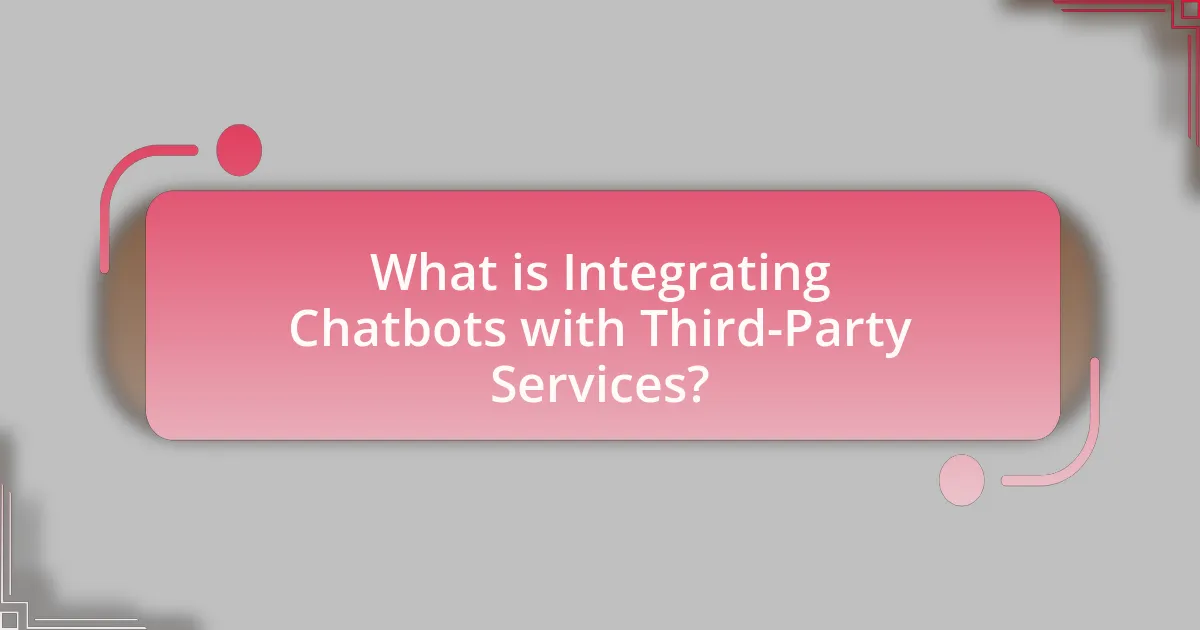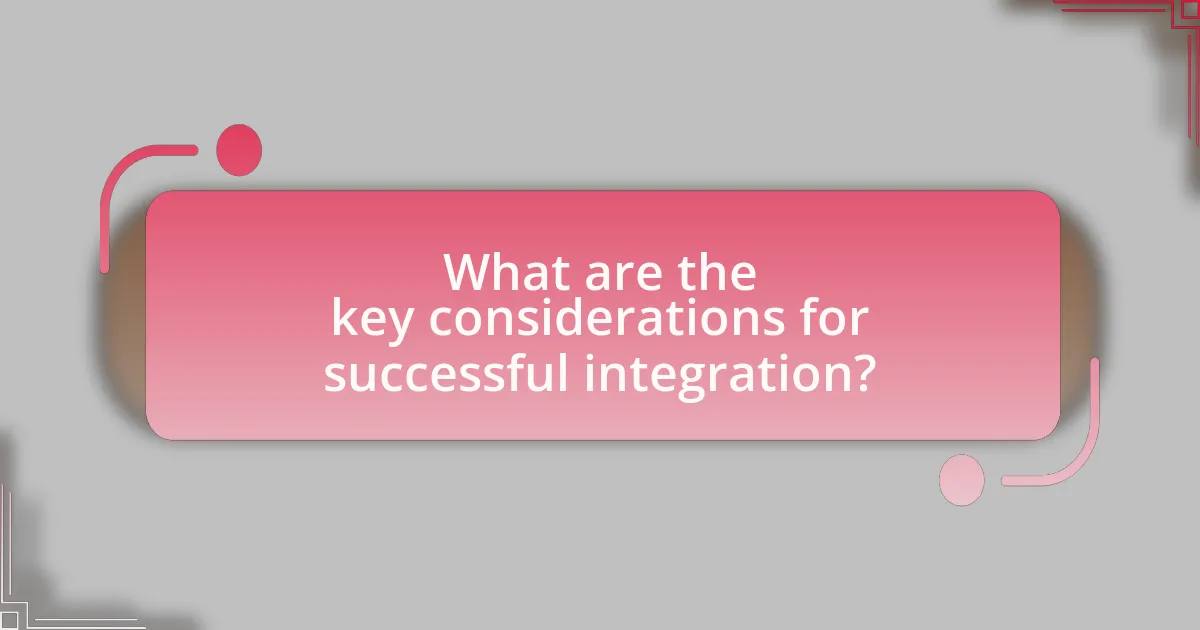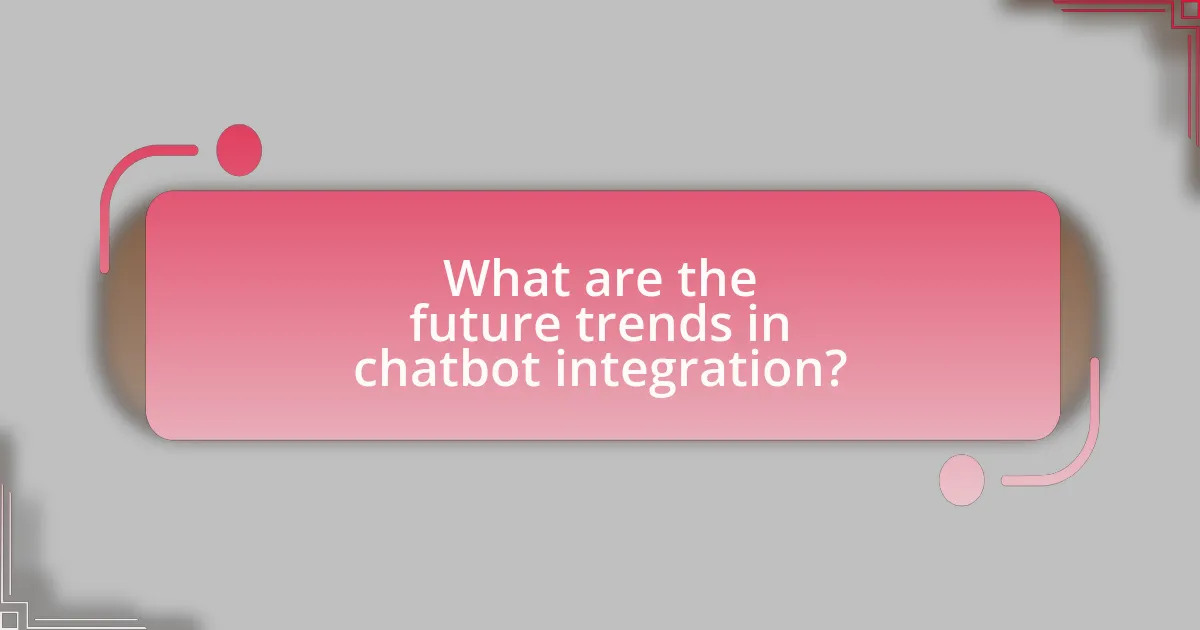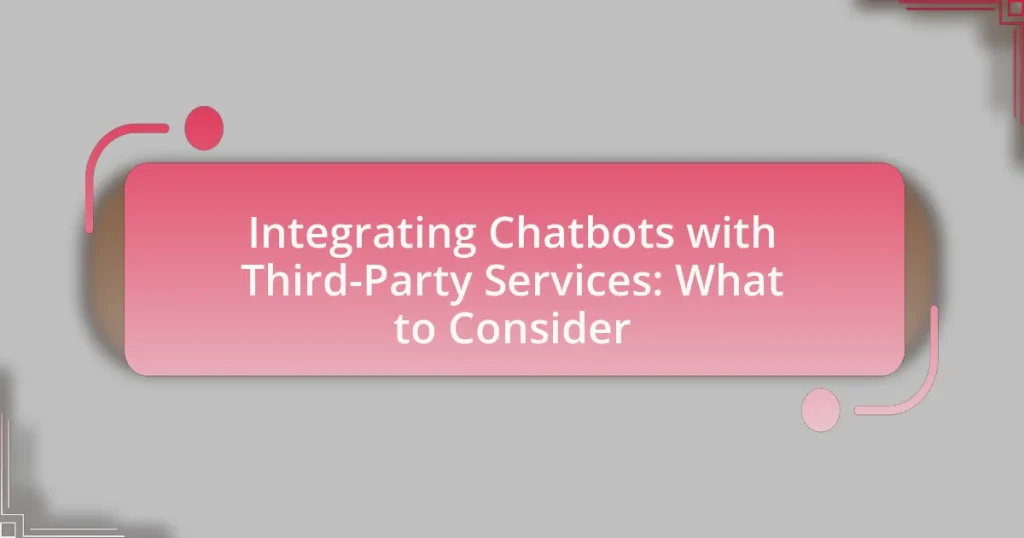Integrating chatbots with third-party services is a crucial process that enhances chatbot functionality by connecting them to external applications and platforms. This integration allows chatbots to access additional data, perform transactions, and utilize services such as payment processing and customer relationship management. The article explores how chatbots interact with third-party services through APIs, the types of services they can integrate with, and the common protocols used for integration. It also addresses the importance of integration for user experience, data management, and operational efficiency, while highlighting the challenges and best practices associated with successful integration. Additionally, the article discusses the cost implications, potential ROI metrics, and emerging technologies shaping the future of chatbot integration.

What is Integrating Chatbots with Third-Party Services?
Integrating chatbots with third-party services involves connecting chatbot systems to external applications or platforms to enhance functionality and provide seamless user experiences. This integration allows chatbots to access additional data, perform transactions, or utilize services such as payment processing, customer relationship management, or social media platforms. For example, a chatbot integrated with a payment gateway can facilitate transactions directly within a chat interface, improving user convenience and engagement.
How do chatbots interact with third-party services?
Chatbots interact with third-party services through APIs (Application Programming Interfaces), which allow them to send and receive data. By utilizing APIs, chatbots can access external functionalities such as payment processing, customer relationship management, and data retrieval from various platforms. For instance, a chatbot can integrate with a payment gateway API to facilitate transactions directly within a chat interface, enhancing user experience and streamlining processes. This interaction is crucial for providing real-time responses and personalized services, as it enables chatbots to leverage the capabilities of external systems effectively.
What types of third-party services can chatbots integrate with?
Chatbots can integrate with various types of third-party services, including customer relationship management (CRM) systems, payment gateways, social media platforms, and analytics tools. These integrations enable chatbots to access customer data, process transactions, engage users on social media, and analyze interactions for improved performance. For instance, integrating with CRM systems like Salesforce allows chatbots to retrieve customer information and provide personalized responses, enhancing user experience and operational efficiency.
What are the common protocols used for integration?
Common protocols used for integration include REST, SOAP, and WebSockets. REST (Representational State Transfer) is widely adopted due to its simplicity and use of standard HTTP methods, making it suitable for web services. SOAP (Simple Object Access Protocol) is a protocol that relies on XML for message formatting and typically uses HTTP or SMTP for message transmission, providing a more rigid structure and built-in error handling. WebSockets enable real-time communication between clients and servers, allowing for full-duplex communication channels over a single TCP connection, which is beneficial for applications requiring instant data exchange. These protocols are foundational in enabling seamless integration between chatbots and third-party services.
Why is integration important for chatbot functionality?
Integration is crucial for chatbot functionality because it enables seamless communication between the chatbot and various external systems, enhancing its capabilities. By integrating with third-party services such as customer relationship management (CRM) platforms, payment gateways, and databases, chatbots can access real-time data, provide personalized responses, and automate complex tasks. For instance, a study by Salesforce found that 70% of customers expect chatbots to understand their context and history, which is only achievable through effective integration with existing systems. This connectivity not only improves user experience but also increases operational efficiency, making integration a fundamental aspect of effective chatbot deployment.
How does integration enhance user experience?
Integration enhances user experience by streamlining interactions and providing seamless access to multiple services within a single platform. This allows users to complete tasks more efficiently, reducing the need to switch between different applications. For instance, integrating chatbots with third-party services like payment processors or customer relationship management systems enables users to make purchases or access account information directly through the chatbot interface. Research shows that 70% of consumers prefer using chatbots for quick communication, highlighting the effectiveness of integration in meeting user expectations for speed and convenience.
What role does integration play in data management?
Integration plays a crucial role in data management by enabling seamless data flow between disparate systems, ensuring that information is consistent, accessible, and actionable. This interconnectedness allows organizations to consolidate data from various sources, improving data quality and reducing redundancy. For instance, a study by Gartner highlights that organizations with integrated data management systems can achieve up to 30% faster decision-making due to real-time access to comprehensive data sets. Thus, effective integration is essential for optimizing data management processes and enhancing overall operational efficiency.
What challenges are associated with integrating chatbots?
Integrating chatbots presents several challenges, including technical compatibility, data privacy concerns, and user experience issues. Technical compatibility arises when chatbots must interface with various third-party services, which may have differing APIs and data formats, complicating integration efforts. Data privacy concerns are significant, as chatbots often handle sensitive user information, necessitating compliance with regulations like GDPR and ensuring secure data transmission. User experience issues can occur if the chatbot fails to understand user intent or provides inaccurate responses, leading to frustration and decreased user satisfaction. These challenges highlight the complexities involved in successfully integrating chatbots into existing systems and workflows.
What technical issues might arise during integration?
Technical issues that might arise during integration include API compatibility problems, data format mismatches, and authentication failures. API compatibility issues occur when the chatbot’s integration requirements do not align with the third-party service’s API specifications, potentially leading to failed requests or unexpected behavior. Data format mismatches can arise when the data structures expected by the chatbot differ from those provided by the third-party service, resulting in errors during data exchange. Authentication failures may occur if the integration does not properly handle authentication tokens or credentials, preventing successful communication between the chatbot and the third-party service. These issues can significantly hinder the integration process and affect the overall functionality of the chatbot.
How can security concerns impact chatbot integration?
Security concerns can significantly impact chatbot integration by limiting the types of data that can be processed and shared. For instance, if a chatbot handles sensitive information, such as personal identification or financial data, organizations may face regulatory compliance issues, such as those outlined in the General Data Protection Regulation (GDPR). This regulation mandates strict data protection measures, which can complicate the integration process with third-party services that may not meet these standards. Additionally, security vulnerabilities in chatbot platforms can lead to data breaches, resulting in financial losses and reputational damage. According to a report by IBM, the average cost of a data breach in 2021 was $4.24 million, underscoring the financial implications of inadequate security measures during chatbot integration.
How can businesses prepare for chatbot integration?
Businesses can prepare for chatbot integration by conducting a thorough assessment of their customer service needs and identifying specific use cases for the chatbot. This involves analyzing customer interactions to determine common queries and pain points, which can guide the chatbot’s design and functionality. Additionally, businesses should select a suitable chatbot platform that aligns with their existing systems and ensure that they have the necessary technical infrastructure in place to support integration. Research indicates that 70% of consumers prefer chatbots for quick communication with brands, highlighting the importance of effective preparation for successful implementation.
What best practices should be followed during integration?
Best practices during integration include thorough planning, clear documentation, and robust testing. Thorough planning ensures that all integration points are identified and understood, which minimizes potential issues. Clear documentation provides a reference for developers and stakeholders, facilitating smoother communication and understanding of the integration process. Robust testing, including unit tests and user acceptance testing, verifies that the integration functions as intended and meets user requirements. These practices are supported by industry standards, which emphasize the importance of structured approaches to integration for successful outcomes.
How can businesses ensure seamless communication between services?
Businesses can ensure seamless communication between services by implementing standardized APIs and utilizing middleware solutions. Standardized APIs facilitate consistent data exchange and interaction protocols, which are crucial for different services to communicate effectively. Middleware solutions act as intermediaries that streamline communication, allowing disparate systems to work together without requiring extensive modifications. For instance, according to a report by Gartner, organizations that adopt API management strategies can improve integration efficiency by up to 30%, demonstrating the effectiveness of these approaches in enhancing service communication.
What testing methods are effective for integrated chatbots?
Effective testing methods for integrated chatbots include unit testing, integration testing, user acceptance testing (UAT), and performance testing. Unit testing focuses on individual components to ensure they function correctly, while integration testing verifies that the chatbot interacts seamlessly with third-party services. User acceptance testing involves real users assessing the chatbot’s performance in real-world scenarios, ensuring it meets user needs. Performance testing evaluates the chatbot’s responsiveness and stability under various loads. These methods are essential for identifying issues early and ensuring a smooth user experience.

What are the key considerations for successful integration?
Successful integration of chatbots with third-party services requires careful attention to compatibility, data security, user experience, and ongoing support. Compatibility ensures that the chatbot can effectively communicate with the third-party service’s API, which is crucial for seamless functionality. Data security is paramount, as sensitive user information must be protected during interactions; compliance with regulations like GDPR is essential. User experience should be prioritized to ensure that the integration enhances the overall interaction, making it intuitive and efficient for users. Finally, ongoing support is necessary to address any issues that arise post-integration, ensuring that the system remains functional and up-to-date. These considerations collectively contribute to a successful integration process.
How do user needs influence integration decisions?
User needs significantly influence integration decisions by dictating the functionalities and features that a chatbot must support to enhance user experience. When users express specific requirements, such as the need for seamless payment processing or real-time customer support, these needs guide developers in selecting appropriate third-party services for integration. For instance, a study by Salesforce found that 70% of consumers expect connected experiences across channels, highlighting the importance of integrating services that align with user expectations. Therefore, understanding user needs ensures that integration decisions are made to create a cohesive and efficient interaction, ultimately leading to higher user satisfaction and engagement.
What user feedback mechanisms can guide integration efforts?
User feedback mechanisms that can guide integration efforts include surveys, usability testing, and analytics. Surveys allow users to provide direct input on their experiences and expectations, which can inform integration decisions. Usability testing helps identify pain points and areas for improvement by observing users interacting with the integrated system. Analytics provide quantitative data on user behavior, revealing trends and patterns that can guide enhancements. For instance, a study by Nielsen Norman Group highlights that usability testing can uncover issues that surveys may not capture, leading to more effective integration strategies.
How can businesses prioritize features based on user needs?
Businesses can prioritize features based on user needs by employing user feedback, data analysis, and market research. By collecting direct input from users through surveys, interviews, and usability tests, businesses can identify which features are most desired. Additionally, analyzing usage data helps to understand which existing features are most utilized and valued by users. Market research provides insights into industry trends and competitor offerings, allowing businesses to align their features with user expectations. This approach is supported by the fact that companies that actively engage with their users and adapt their products accordingly often see higher customer satisfaction and retention rates.
What are the cost implications of integrating chatbots?
Integrating chatbots incurs various cost implications, primarily including initial development expenses, ongoing maintenance costs, and potential integration fees with third-party services. Development costs can range from a few thousand to several hundred thousand dollars, depending on the complexity and customization required. Ongoing maintenance typically involves updates, monitoring, and troubleshooting, which can add an estimated 15-20% of the initial development cost annually. Additionally, integrating chatbots with third-party services may involve subscription fees or transaction costs, which can vary widely based on the service provider. For instance, a study by Gartner indicates that organizations can expect to save up to 30% in customer service costs by implementing chatbots, highlighting the long-term financial benefits despite initial investments.
How can businesses budget for integration projects?
Businesses can budget for integration projects by assessing the total cost of ownership, which includes initial development, ongoing maintenance, and potential scalability costs. A detailed analysis of the required resources, such as software licenses, hardware, and personnel, is essential. According to a study by the Project Management Institute, 39% of projects fail due to poor planning, highlighting the importance of a comprehensive budget that accounts for unforeseen expenses. Additionally, businesses should consider the return on investment (ROI) from the integration, as effective budgeting can lead to improved efficiency and customer satisfaction, ultimately justifying the initial costs.
What are the potential ROI metrics for chatbot integration?
The potential ROI metrics for chatbot integration include cost savings, increased sales, customer satisfaction scores, and engagement rates. Cost savings can be quantified by measuring reductions in customer service staffing and operational expenses, as chatbots can handle a significant volume of inquiries without human intervention. Increased sales can be assessed through conversion rates attributed to chatbot interactions, with studies indicating that chatbots can boost sales by up to 30%. Customer satisfaction scores can be tracked through post-interaction surveys, revealing improvements in user experience and response times. Engagement rates can be measured by analyzing user interactions and retention metrics, demonstrating how effectively chatbots maintain customer interest and loyalty. These metrics collectively provide a comprehensive view of the financial and operational benefits derived from chatbot integration.
What tools and platforms facilitate chatbot integration?
Tools and platforms that facilitate chatbot integration include Dialogflow, Microsoft Bot Framework, and IBM Watson Assistant. Dialogflow, developed by Google, provides natural language processing capabilities and integrates seamlessly with various messaging platforms like Facebook Messenger and Slack. Microsoft Bot Framework offers a comprehensive set of tools for building and connecting chatbots across multiple channels, including Skype and Teams. IBM Watson Assistant allows developers to create conversational interfaces and integrates with numerous third-party applications, enhancing functionality and user experience. These platforms are widely recognized for their robust features and ease of integration, making them essential for effective chatbot deployment.
Which popular platforms offer integration capabilities?
Popular platforms that offer integration capabilities include Zapier, Microsoft Power Automate, and Integromat. These platforms enable users to connect various applications and automate workflows without extensive coding knowledge. For instance, Zapier supports integration with over 3,000 apps, allowing seamless data transfer and task automation. Microsoft Power Automate integrates with Microsoft 365 applications and numerous third-party services, facilitating efficient business processes. Integromat, now known as Make, provides a visual interface for connecting apps and automating complex workflows, supporting a wide range of integrations.
How do APIs play a role in chatbot integration?
APIs facilitate chatbot integration by enabling communication between the chatbot and external services or platforms. They allow chatbots to access data, perform actions, and utilize functionalities from third-party applications, enhancing the chatbot’s capabilities. For instance, a chatbot can use an API to retrieve weather information from a weather service, providing users with real-time updates. This integration is crucial for creating dynamic and responsive chatbots that can interact with various systems, thereby improving user experience and operational efficiency.

What are the future trends in chatbot integration?
Future trends in chatbot integration include enhanced AI capabilities, increased personalization, and seamless multi-channel experiences. Enhanced AI capabilities will allow chatbots to understand and process natural language more effectively, leading to improved user interactions. Increased personalization will enable chatbots to tailor responses based on user data and preferences, enhancing customer satisfaction. Seamless multi-channel experiences will ensure that chatbots can operate across various platforms, such as social media, websites, and messaging apps, providing a consistent user experience. According to a report by Gartner, by 2025, 75% of customer service interactions will be powered by AI, highlighting the growing reliance on advanced chatbot integration in business operations.
How is AI influencing chatbot integration with third-party services?
AI is significantly enhancing chatbot integration with third-party services by enabling more seamless interactions and data exchanges. This influence is evident through the use of natural language processing (NLP) and machine learning algorithms, which allow chatbots to understand and respond to user queries more effectively. For instance, AI-driven chatbots can access and utilize APIs from third-party services, facilitating real-time data retrieval and processing. According to a report by Gartner, by 2025, 75% of customer service interactions will be powered by AI, underscoring the growing reliance on AI for efficient service integration. This capability not only improves user experience but also streamlines operational workflows, making it easier for businesses to leverage multiple platforms simultaneously.
What emerging technologies are shaping the future of chatbot integration?
Emerging technologies shaping the future of chatbot integration include artificial intelligence (AI), natural language processing (NLP), machine learning (ML), and voice recognition. AI enhances chatbots’ ability to understand and respond to user queries more effectively, while NLP allows for more human-like interactions by interpreting context and sentiment. Machine learning algorithms enable chatbots to learn from user interactions, improving their responses over time. Voice recognition technology facilitates hands-free communication, expanding the usability of chatbots across various platforms. These technologies collectively enhance the functionality and user experience of chatbots, making them more efficient and versatile in integration with third-party services.
How can businesses stay ahead of integration trends?
Businesses can stay ahead of integration trends by continuously monitoring technological advancements and adopting agile integration strategies. This involves regularly assessing emerging technologies, such as artificial intelligence and machine learning, which are increasingly being integrated into chatbots and third-party services. According to a report by Gartner, organizations that prioritize integration capabilities can achieve up to 30% faster time-to-market for new services. By investing in training for their teams and leveraging integration platforms that facilitate seamless connectivity, businesses can enhance their operational efficiency and customer experience, ensuring they remain competitive in a rapidly evolving landscape.
What practical tips can enhance chatbot integration success?
To enhance chatbot integration success, prioritize clear objectives and user experience. Establishing specific goals for the chatbot’s functionality ensures alignment with business needs, while focusing on user experience fosters engagement and satisfaction. Research indicates that 70% of consumers prefer chatbots for quick communication, highlighting the importance of intuitive design and responsiveness. Additionally, integrating analytics tools allows for ongoing performance monitoring, enabling continuous improvement based on user interactions and feedback.
How can ongoing maintenance improve integrated chatbot performance?
Ongoing maintenance enhances integrated chatbot performance by ensuring the system remains updated, functional, and aligned with user needs. Regular updates to the chatbot’s algorithms and databases can improve response accuracy and relevance, as evidenced by a study from the Journal of Artificial Intelligence Research, which found that chatbots with frequent updates showed a 30% increase in user satisfaction. Additionally, ongoing maintenance allows for the identification and resolution of bugs or issues that may hinder performance, leading to a more seamless user experience. This proactive approach not only optimizes the chatbot’s capabilities but also fosters user trust and engagement over time.
What resources are available for troubleshooting integration issues?
Resources available for troubleshooting integration issues include official documentation, community forums, and technical support services. Official documentation provides detailed guidelines and troubleshooting steps specific to the integration platform, ensuring users have access to accurate information. Community forums, such as Stack Overflow or GitHub discussions, allow users to share experiences and solutions, fostering collaborative problem-solving. Technical support services from the integration provider offer expert assistance for complex issues, ensuring timely resolution. These resources collectively enhance the troubleshooting process by providing diverse avenues for obtaining help and information.










